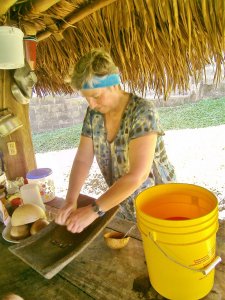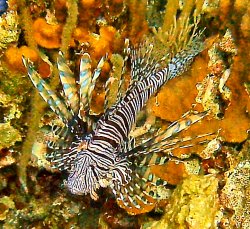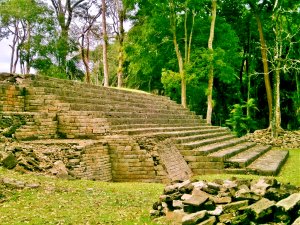 I didn’t expect to see a scarlet poinsettia flowering in the jungle, but there it was. More gangly and much larger than the Christmas plants we buy in England or America. “You better Belize it” as they say round here! We were on Mr Eladio Pop’s cacao farm, deep in the rainforest of southern Belize. Eladio welcomed us, and started off the tour, and then his son Feliciano, who also works on the farm, joined us and continued. He led us through the forest, showing us how they plant the cacao trees under shade trees. The cacao needs the shade, and planting shade trees helps to maintain the cedar and mahogany trees of the forest. Cacao trees are fascinating; the large pods grow directly from the trunk and branches. We tasted cacao seeds pried out of their sticky flesh inside the pod. We tasted apple bananas, and small Belizean bananas. We crushed the anise-flavored leaves of an allspice tree in our hands, and deeply inhaled the spicy, somewhat lemony scent. The Mayans drink the infused leaves as an energy-giving tea, and add a few roasted allspice berries to their chocolate. We tried our hands at grinding the roasted beans, and saw the dry bean magically transformed into sticky raw chocolate. What a fascinating day!
I didn’t expect to see a scarlet poinsettia flowering in the jungle, but there it was. More gangly and much larger than the Christmas plants we buy in England or America. “You better Belize it” as they say round here! We were on Mr Eladio Pop’s cacao farm, deep in the rainforest of southern Belize. Eladio welcomed us, and started off the tour, and then his son Feliciano, who also works on the farm, joined us and continued. He led us through the forest, showing us how they plant the cacao trees under shade trees. The cacao needs the shade, and planting shade trees helps to maintain the cedar and mahogany trees of the forest. Cacao trees are fascinating; the large pods grow directly from the trunk and branches. We tasted cacao seeds pried out of their sticky flesh inside the pod. We tasted apple bananas, and small Belizean bananas. We crushed the anise-flavored leaves of an allspice tree in our hands, and deeply inhaled the spicy, somewhat lemony scent. The Mayans drink the infused leaves as an energy-giving tea, and add a few roasted allspice berries to their chocolate. We tried our hands at grinding the roasted beans, and saw the dry bean magically transformed into sticky raw chocolate. What a fascinating day!
Belize is a small country with so many things going for it. An interesting cultural and ethnic mix, Belizeans are made up of Maya, Mestizo, Kriol, Garifuna, East Indian, Mennonite, Arab and Chinese. The official language is English, but many Belizeans speak Kriol, which is an interesting mix of words! The Mayans speak their own Mayan languages of course. There is exciting scuba-diving around the largest barrier reef in the northern hemisphere, there are rainforests with a wide diversity of birds and animals to discover, there are Mayan ruins to explore, but most importantly we have met so many friends here, the people make this country special. We’ve only been in Belize for five weeks, but riding around Punta Gorda town on our rented bikes, everyone waves and calls hello. This is our fifth visit to Belize and our third to PG, and now that we’ve spent some time on land (we always used to come just for the scuba-diving!) we’ve had so much fun going to barbecues, enjoying small restaurants and hanging with the locals.
 When we first came to PG a few years ago, it was to go diving with reef conservation organization ReefCI. The diving is always good, and it’s great to feel like we’re doing our small part in helping gather information to save this beautiful reef. In addition to reef surveys, we also spear the invasive lionfish. Lionfish were released into the Caribbean waters by accident, have no natural predators, and are voracious predators of the native juvenile reef fish. They are causing a massive imbalance to the entire reef ecosystem throughout the Caribbean. Many of the islands have spearing programs, and fortunately lionfish make good eating. They can release 50,000 eggs every 4 days, so we humans have to keep spearing to keep up with them. We keep hoping that some of the larger fish here will learn to predate them.
When we first came to PG a few years ago, it was to go diving with reef conservation organization ReefCI. The diving is always good, and it’s great to feel like we’re doing our small part in helping gather information to save this beautiful reef. In addition to reef surveys, we also spear the invasive lionfish. Lionfish were released into the Caribbean waters by accident, have no natural predators, and are voracious predators of the native juvenile reef fish. They are causing a massive imbalance to the entire reef ecosystem throughout the Caribbean. Many of the islands have spearing programs, and fortunately lionfish make good eating. They can release 50,000 eggs every 4 days, so we humans have to keep spearing to keep up with them. We keep hoping that some of the larger fish here will learn to predate them.
On land, there’s quite a bit to keep visitors busy. Here in southern Belize, it’s still quite unspoilt. We wandered through the Mayan ruins of Lubaantun, admiring the precision of stonework put together without mortar. The earthship home being built by the English family just down the road from Lubaantun is worth a visit too. They’re building out of old bottles, old tires filled with mud, and covered with concrete. We had a truly exciting day at Blue Creek, ziplining through the rainforest canopy, spotting some of Belize’s brightly-colored birds, followed by a swim/walk through Hokeb Ha cave. We’ve tried our hands at grinding roasted cacao beans, and drank hot chocolate with the Mayan family on their chocolate farm.
Belize has a population of only about 340,000 people, and with a slightly chancy group of politicians in the government, many things that in other countries might be funded out of taxation, just don’t happen here. The health service is patchy, the roads are often potholed. Schools frequently partner with a variety of churches in order to get the necessary funding.  So there’s often a fairly large number of volunteers and NGOs of various types, spending time here, helping to build schools, working with local doctors, or trying to identify entrepreneurial opportunities, particularly for the youth. It’s an interesting situation, and as I’m not an economist, I’m not really qualified to give an opinion. We have met many Belizeans who care about, and work hard to improve the economy and many who also work in the environmental field.
So there’s often a fairly large number of volunteers and NGOs of various types, spending time here, helping to build schools, working with local doctors, or trying to identify entrepreneurial opportunities, particularly for the youth. It’s an interesting situation, and as I’m not an economist, I’m not really qualified to give an opinion. We have met many Belizeans who care about, and work hard to improve the economy and many who also work in the environmental field.
We’ve found the Belizean people incredibly friendly and welcoming to visitors. There’s also a government-sponsored program for older people from other countries who want to retire here, which makes it very easy to do. Belize is an interesting mix: it’s in Central America, but they speak English, and it has a laid-back Caribbean island feel to it. Although we’re continuing our travels around the world, I feel sure that we’ll come back to Belize one day.

Leave a Reply